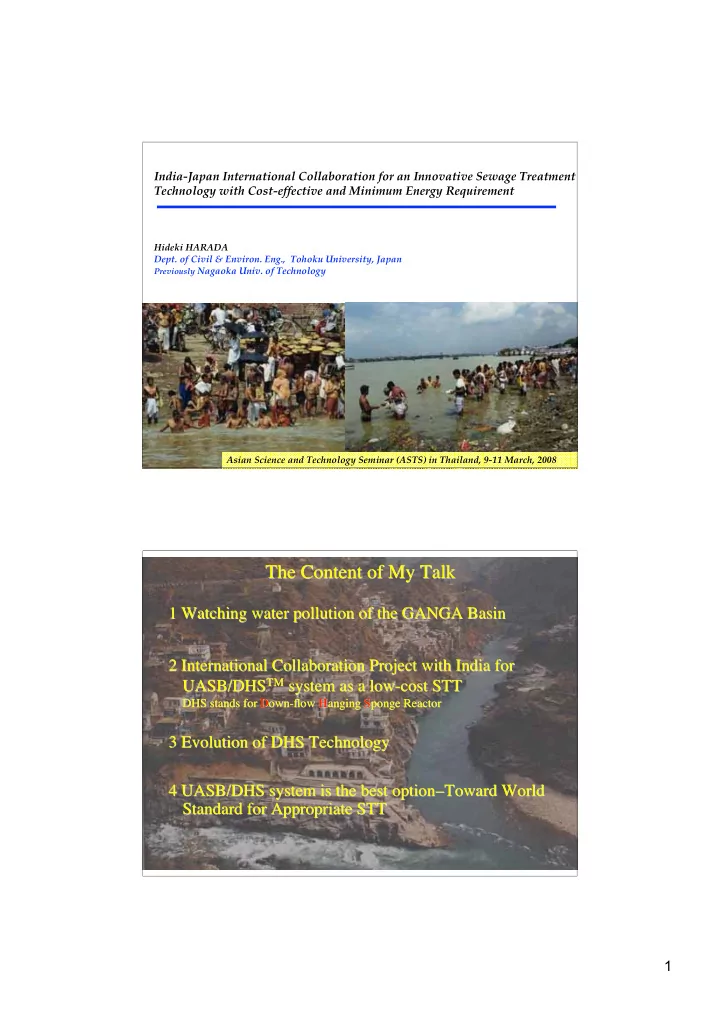

India-Japan International Collaboration for an Innovative Sewage Treatment Technology with Cost-effective and Minimum Energy Requirement Hideki HARADA Dept. of Civil & Environ. Eng., Tohoku University, Japan Previously Nagaoka Univ. of Technology Asian Science and Technology Seminar (ASTS) in Thailand, 9-11 March, 2008 The Content of My Talk The Content of My Talk 1 Watching water pollution of the GANGA Basin 1 Watching water pollution of the GANGA Basin 2 International Collaboration Project with India for 2 International Collaboration Project with India for UASB/DHS TM TM system as a low-cost STT system as a low-cost STT UASB/DHS DHS stands for DHS stands for D D own-flow own-flow H H anging anging S S ponge Reactor ponge Reactor 3 Evolution of DHS Technology 3 Evolution of DHS Technology 4 UASB/DHS system is the best option 4 UASB/DHS system is the best option– –Toward World Toward World Standard for Appropriate STT Standard for Appropriate STT 1
2
Scene 3: Delhi, India Urban Drainage Urban Drainage Scene 3: Delhi, India Urban Drainage Urban Drainage flows flows 3
Scene 4: Delhi, India Urban Drainage flows Urban Drainage flows into the Yamuna Yamuna into the without treatment without treatment Pollution of the YAMUNA RIVER, DO and BOD Water Quality Standard for Bathing 4
Ganga Ganga Action Plan (GAP), then Action Plan (GAP), then Yamuna Yamuna Action Plan (YAP) Action Plan (YAP) Started : 1986 (5 year plan, later extended) Phases GAP-II GAP-I Ganges 2001 1986 1991 YAP Yamuna 1993 1996 2001 Actions • Construction of sewage treatment plants (STP) • Public Toilets • Crematoria • River Front Facility (Bathing ghats) • Industrial pollution- Control by existing environmental law • Agricultural source- by concerned ministry (reduce pesticides) •Biological Regeneration 5
From GAP to YAP, from ASP to UASB From GAP to YAP, from ASP to UASB (Stabilization Pond) Abandoned Activated Sludge Plant 6
7
4 UASB Reactors Each UASB has a size of 32m! 24m, receiving 10 MLD (10000 m3/day, or 70,000 I.E) Fate of Byproduct, Biogas and Excess Sludge 8
HRT=8 hr BOD removal � � 60% Remaining BOD 80 �� 20 mg/L Discharge Standard BOD <30 mg/L TSS < 50 mg/L F-coli < 10,000 MPN/100 mL UASB effluent is introduced to 1 day HRT of Final Polishing Unit FPU (stabilization pond). Polishing pond is working as an algae growth pond. 9
40 MLD Capacity 10
Harada et al (2005), Jour. of Environ. Management 11
Visit of Indian Government Delegation to Nagaoka, Feb. 2002 12
DHS reactor under construction, December 2001, at Karnal, India 13
14
Sending Graduate-students to Karnal STP site since Oct. 2002 Fuel is, of course, cow-dung Put into curry-pot 15
Overall Summary Result of 5-ys non-stop operation 16
17
18
General Advantages of DHS post-treatment System • No need of External Aeration, much less energy requirement • No clogging, no back-washing, no laborious maintenance • Much less amount of Excess Sludge • Less Area Requirement • High Performance at equivalent HRT to Activated Sludge Process 19
20
DHS concept Wastewater (downflow) Hanging sponge in air Polyurethane foam (PUF) air air No need of External aeration input 21
Evolution of DHS Process 22
BOD removal by Activated Sludge process throughout Japan Statistics of Japan Sewage Works, 2001 Effluent BOD (mg/l) Influent BOD (mg/l) 23
BOD removal by (UASB+DHS) system (Karnal, India) C-BOD5 removal in Karnal; Dec. 2002 to Dec. 2003 UASB & DHS BOD (mg/l) Raw sewage BOD (mg/l) Power consumption for sewage treatment Total power Water Sludge consumption Pumping treatment treatment Others Total; x10 3 kWh/yr 5,956,000 896,000 2,913,000 1,359,000 739,000 Percentage 100.0 15.0 48.9 22.8 12.4 per WW amount treated; kWh/m 3 0.46 0.07 0.22 0.1 0.06 Amount of treated water; m 3 per capita; kWh/capita/yr 73.5 13,019,790,000 Population; capital 81,076,000 Power consumption per amount of sewage; 0.46 kWh/m 3 Statistic of Japan Sewage Works, 2001 Others Pumping 12.4% 15.0% Pumping Sludge Water treatment 22.8% treatment Sludge treatment Others 48.9% Aeration 24
How much power should be required for Sewage Treatment, if Activated Sludge Process is employed? Per capita Annual Sewage Amount =175 liter � day -1 =63.4 m 3 � capita -1 � yr -1 Per capita Annual Power Requirement for Sewage Treatment=63.4 m 3 � capita -1 � yr -1 ! 0.46 kwh � m -3 =29.2 kwh � capita -1 � yr -1 Annual Power Requirement for Sewage Treatment � Per Capita � � � � � � � � � � � � � � � � � � � � �� � � � � � � Country Annual Power Consumption (kWh/capita·year) Nepal 66 44.0 Bangladesh 103 28.3 Myanmar 130 21.7 Laos 140 20.9 Sri Lanka 301 9.7 Vietnam 333 8.8 Indonesia 379 7.7 Pakistan 413 7.1 India 473 6.2 Philippines 497 5.9 Columbia 954 3.1 Mexico 1778 1.6 Brazil 1846 1.6 World 2206 1.3 Japan 7230 0.4 UAE 14153 0.2 CIA World Fact Book � (2003) Conclusive Remarks Conclusive Remarks � 1. Our Proposed UASB-DHS combined system exhibited an excellent performance, producing Effluent BOD less than 10 mg/L with a HRT of only 8 h (UASB 6 h and DHS 2h) that is equivalent to that of conventional ASP. 2. The UASB-DHS combined system requires • no external forced aeration, • no laborious maintenance, • less sludge production, • less land area, • resulting in reducing running cost into only 1/5-1/10 of conventional ASP. 3. The UASB-DHS combined system may offer the best option for low-cost and low-energy treatment of municipal wastewater under tropical/sub- tropical climate. 25
26
Recommend
More recommend